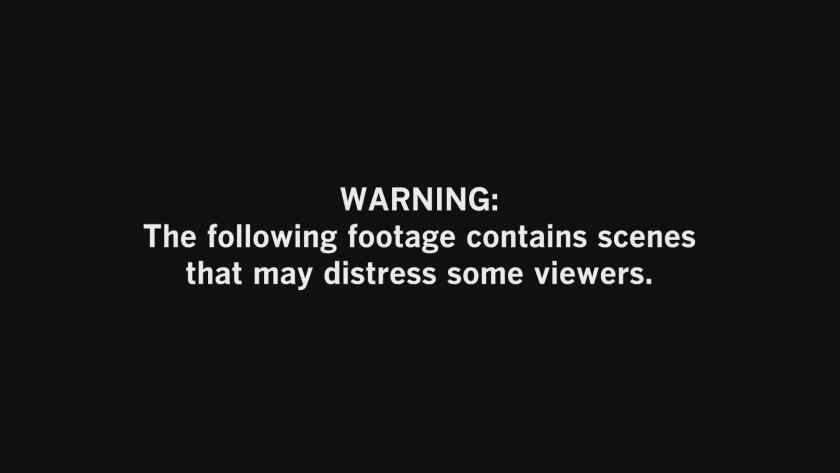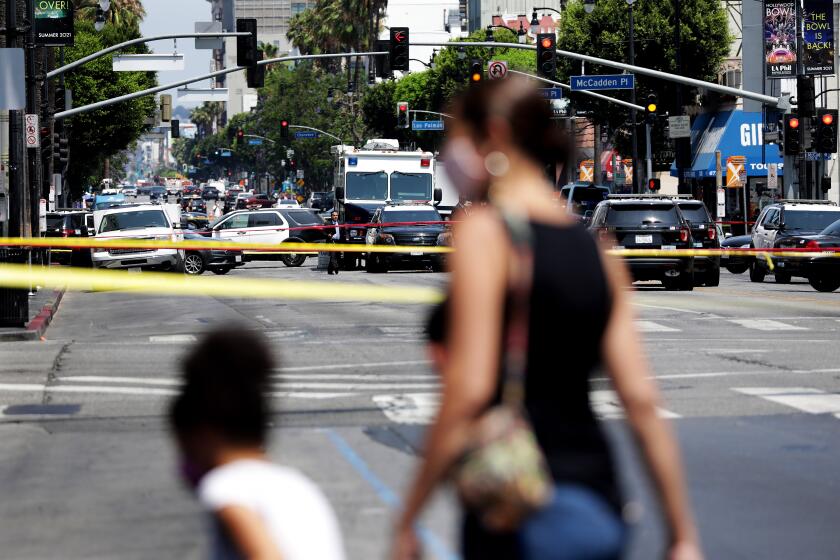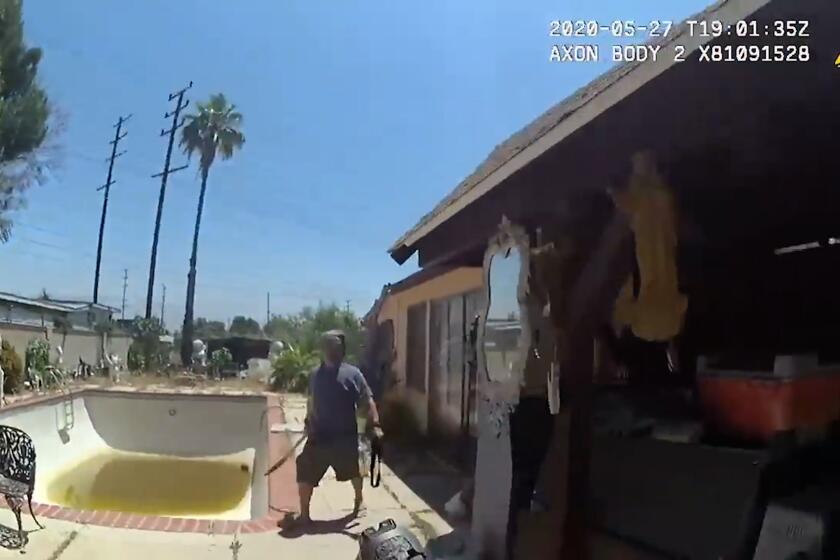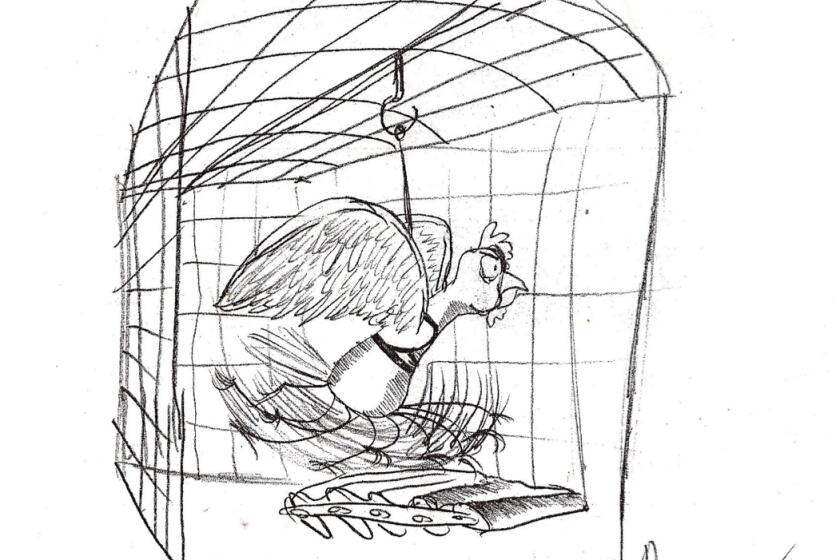String of LAPD shootings exposes L.A.’s broken mental health system, officials say
LAPD officials and mental health advocates alike say a recent string of LAPD shootings reflect a broken mental health system that, like the shootings themselves, deserves scrutiny.
When a 19-year-old tourist from Singapore was stabbed in the abdomen on Hollywood Boulevard last month, witnesses and the victim quickly pointed out the suspect to police.
Police already knew the man, Grisha Alaverdyan, from prior encounters.
Alaverdyan, 27, had been arrested and charged two weeks earlier with grand theft auto and hit-and-run, then released pending trial, according to court records. In February, he was sentenced to 30 days in jail and a year of probation for vehicle theft and assaulting an officer. And since 2018, police said, he had been assessed at least eight times by the Los Angeles Police Department’s Mental Evaluation Unit.
Now, Alaverdyan appeared to be in crisis once more as he held up a knife not far from where the stabbing occurred, according to body-camera video from the scene. He laughed and thrust his hips as officers trained their weapons on him. Then he moved toward them, knife still in hand, and they shot him with a live round and a beanbag projectile.
Los Angeles police officers have opened fire more times this year than in all of last year or the year before, according to LAPD data tracked by The Times.
Alaverdyan’s case, like several other police shootings in recent months, highlighted a troubling trend of LAPD officers opening fire on suspects with mental illnesses, but also a broader failure of the mental health system to get people the care they need when they repeatedly fall into crisis on the street or come into contact with police in less serious encounters.
Instead, in L.A. and around the region, people with mental illnesses are cycled through what police, mental health officials and advocates agree is a dizzying, revolving door of temporary psychiatric units and jail wards, never getting the long-term care they need before they are pushed back onto the street until they eventually wind up dead or in police custody on a serious enough charge to keep them incarcerated for good.
About a third of the more than 30 people shot by LAPD officers this year are believed to have had a mental illness at the time. Most had been previously assessed and found to be ill.
The trend has outraged those who want police removed from situations involving people with mental illnesses, and who believe officers open fire too quickly on people in crisis, particularly those with edged weapons like knives. That outrage has fueled discussions about defunding police.
The shootings have also caused mounting frustration among police officers and mental health officials and advocates, who say the broken mental health system deserves as much scrutiny as the shootings themselves.
Too few people with mental illnesses who fall into crisis or get arrested for minor infractions are successfully transitioned into longer-term care or housing before things escalate, they said — a reality driven by a decades-old legal system that shut asylums and state mental health institutions without ever standing up the community-based care options and beds that were originally envisioned to replace them.
The day before Alaverdyan was shot by officers, police shot a woman named Evelyn Del Real as she allegedly stabbed her young son with a knife, police said. The same day, LAPD officers wounded a man named Tony Yoon with a projectile weapon as they took him into custody after he allegedly set his parents’ house on fire during a standoff.
Less than a week later, on Oct. 6, LAPD officers shot a woman named Victoria Bardales after she allegedly came out of a tent at a homeless encampment holding another woman hostage at gunpoint and fired at officers. On Oct. 13, officers fatally shot a man named Carlos Arias after responding to a report of an assault with a deadly weapon in Palms and allegedly finding him assaulting his mother with a meat cleaver.
Like Alaverdyan, police said that Del Real, Yoon, Bardales and Arias had all been previously assessed by the LAPD’s Mental Evaluation Unit — Arias at least three times. Bardales had also been arrested on suspicion of possessing a loaded firearm and released without bail the day before she was shot, after a cemetery guard reported her wandering around with a handgun and an ax, police said.
Police officials say such weapons represent real, imminent threats. Others claim the danger is exaggerated and that officers are too quick to pull the trigger.
Mental health officials and advocates warned against associating violence with people with mental illnesses, many of whom never become violent, and said the LAPD’s record of shooting people in crisis must be scrutinized and addressed — including by having more trained clinicians on scene to advise officers.
They also said it isn’t fair to solely blame officers for tragic outcomes between police and those with mental illnesses when the system they are operating within is essentially designed to create such encounters.
“The bottom line is that the mental health systems in this country, and this state and this county, are completely inadequate,” said Dr. Jonathan Sherin, L.A. County’s director of mental health. “We have what I call the open-air asylum of the street, and the closed-air asylum of the jail.”
Sherin said government officials for years have dumped substantial funding into police agencies and far too little into mental health programs, forcing them to then rely on the police to deal with growing mental illness in the community — even though police are ill-equipped and poorly trained to do so.
“We are in a position now where we need to relieve [the police] of, frankly, a burden that they don’t deserve. They’re not set up for it, they’re not equipped, and it’s a cultural mismatch,” Sherin said. “In a perfect world, we wouldn’t just have a police beat, we would have a mental health beat.”
“I don’t blame [police] for being frustrated,” said Mark Gale, a longtime advocate and policy advisor with the National Alliance on Mental Illness, who chairs the NAMI Greater Los Angeles County criminal justice committee. “They see the same people over and over again.”
In a recent discussion about the string of shootings before the civilian Police Commission, which reviews all police shootings and rules on whether they were justified, LAPD Chief Michel Moore praised his officers for confronting armed individuals who in some cases were threatening hostages. But he also said the cases showed a pattern of failures on the part of the mental health and criminal justice systems to assist and stabilize people in crisis the first time police bring them to hospitals and jails.
“The other parts of our system are failing, and failing miserably,” Moore said.
The department, in its own statement on the trend, said individuals experiencing mental illness are not just drawing weapons in encounters with police but driving other forms of violence in the city as well.
“The number of persons who are in and out of treatment for mental illnesses and who are oftentimes released from institutions without an adequate support system in place upon release has exacerbated the high levels of violence we are experiencing in the city,” the department said.
And that is not for a lack of effort on the LAPD’s part to intervene and connect such residents with care, it said.
Class of ‘91: While some deeply disturbed patients prospered in local treatment, others fell through the huge gaps in services--sometimes to their deaths.
When police officers encounter someone who appears to be a danger to themselves or others or who is “gravely disabled,” they can fill out a form to have them assessed by medical staff and potentially held involuntarily for evaluation and care for up to 72 hours. It’s generally referred to as a 5150 — and it happens all the time.
In the first seven months of this year, LAPD patrol officers filled out 3,724 such requests, while officers on the Systemwide Mental Assessment Response Team — or SMART, which is part of the Mental Evaluation Unit — filled out another 3,585, said Capt. Brian Bixler, who oversees the unit.
Those numbers aren’t unusual, and would be even higher had the department not begun diverting calls from people with suicidal thoughts to clinicians this year.
While 2020 was an anomaly in that it drove down all sorts of calls for service and police responses, Bixler said, past years saw equally high numbers of 5150 requests. In 2019, SMART and patrol officers filed a combined 11,595 such requests, and in 2018 they filed 11,753.
If doctors believe a person brought in on a 5150 should remain in care after the initial 72-hour hold, they can petition for a person to be held longer or placed under a conservatorship that would place decisions about their care in the hands of a loved one or an assigned overseer, but that requires a hearing in which the patient is assigned an advocate to argue on their behalf.
Dr. Curley Bonds, a psychiatrist and the county mental health department’s chief medical officer, previously oversaw patients’ rights in such settings, and said the system is generally designed to protect people’s freedom and liberty — which he said is appropriate.
However, the system “has limits and it also has some gaps,” Bonds said.
People often stabilize to some degree during their initial treatment, and when they no longer qualify as an “acute” patient, hospitals stop being reimbursed at the same level and have an incentive to get them out the door, Bonds said. Some public hospitals are proactive about filing for conservatorships instead, but private hospitals less so, he said.
Many patients in that situation would benefit from moving from an acute bed into a subacute bed, or into what’s known as assisted outpatient treatment, Bonds said. But the region has a vastly insufficient number of such placements and care providers, he said, so many people land back on the street before they are totally stable — and back on the radar of police soon after.
Sherin, the county mental health director, said the system needs to be overhauled from top to bottom.
Sherin said the county needs to quadruple the number of clinicians it has on staff to respond to people in crisis on the street, and offer competitive salaries to attract candidates willing to do such work at all hours. The county also needs to vastly increase the number of beds it has for people in mental crisis, he said, especially those who are not in acute distress but are rebuilding after a serious episode.
Sherin said officials must push harder to redirect state funding to mental illness treatment, and to change state and federal policies that originated as well-meaning efforts to end the inhumane warehousing of patients with mental illnesses but now impede progress.
One particularly problematic rule, he said, bars federal funding for treatment in mental health facilities with more than 16 beds, which forces local governments like L.A. County to build multiple smaller facilities with different contractors — at greater cost and with greater overhead — if they want to substantially increase bed capacity.
“You can only imagine how inefficient and confusing and administratively challenging it is to do that kind of crap,” he said.
There can be tension between people with mental health challenges who want autonomy over their healthcare and medical providers or family members who believe it’s best to force treatment. How do the laws work, and how can people advocate for the best outcomes?
Sherin also wants to change the standard for when a person can be involuntarily treated, because the current standard — that they are a danger to themselves or others or are “gravely disabled” — is too onerous and confusing, and is “interpreted by different providers, by different judges, by different courts” in different ways.
Currently, he said, someone who consistently lives on the street, cannot hold a job, routinely falls into serious crises and is ignoring potentially deadly medical conditions — like untreated cancer, or even a gangrenous foot — still may not qualify.
Sherin said the changes must be geared toward ensuring that those who are in care are brought back into the fold of society — rather than left to suffer at its edges.
“It’s not just a one-time investment — it’s an ongoing investment,” Sherin said.
Gale, the advocate with NAMI who fought for years to get his own son into long-term care, said the way the system handles people with mental illnesses is disgraceful.
Moving them in and out of temporary psychiatric units without securing them longer-term care until they become so ill that they spiral further out of control, die or are arrested is akin to an oncologist telling a patient with early signs of cancer to only come back for treatment once they’ve developed advanced cancer, Gale said.
“That’s what we do to people with mental illness,” he said. “The law allows people to deteriorate.”
About a month after Alaverdyan was shot by police off Hollywood Boulevard, he shuffled into a mental health courtroom in Hollywood in a blue padded jumpsuit. His hands were shackled, and a vacant expression clouded his face. His mother and brother were there, his mother whispering his name as she held back tears, but he didn’t acknowledge them. It was hard to tell if he even realized they were there, despite their sitting a few yards away.
Reviewing the case, a judge quickly found Alaverdyan incompetent to stand trial on the charges against him, including assault with a deadly weapon, and ordered him to receive mental health treatment pending a follow-up hearing.
The review over, Alaverdyan was walked away, not once looking back, and his family — who declined to comment — left the room, unsure of what would happen next.
More to Read
Sign up for Essential California
The most important California stories and recommendations in your inbox every morning.
You may occasionally receive promotional content from the Los Angeles Times.















